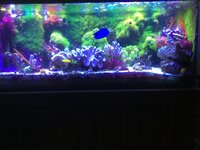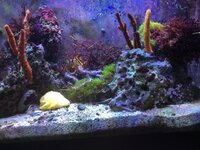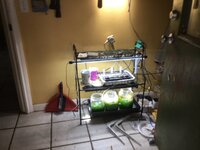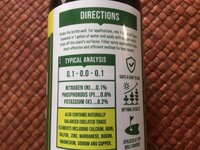What are you keeping in your system currently?
-
Welcome back Guest!MARSH is a private reefing group. Comments and suggestions are encouraged, but please keep them positive and constructive. Negative threads, posts, or attacks will be removed from view and reviewed by the staff. Continually disruptive, argumentative, or flagrant rule breakers may be suspended or banned.
You are using an out of date browser. It may not display this or other websites correctly.
You should upgrade or use an alternative browser.
You should upgrade or use an alternative browser.
Nutrient management by Old School Reefer (1 Viewer)
- Thread starter Subsea
- Start date
- Tagged users None
Users who are viewing this thread
Total: 2 (members: 0, guests: 2)
You don’t consider 1000 gallons of macro algae nutrient export?So with a 150G reef tank in my new home, I plumbed a remote sump that grew into 1000G of algae refugiums and two propagation/growout troughs that were 4’ by 8’ by 12” high. With zero nutrient export
Patrick…so the focus of this thread is recycling nutrients. I’m a little confused what you’re trying to accomplish. Why do you want to recycle nutrients.? I missed that part.
Also, may I ask the current nutrient numbers.
I have unopened test kits that expired 10 year ago.You don’t consider 1000 gallons of macro algae nutrient export?
Patrick…so the focus of this thread is recycling nutrients. I’m a little confused what you’re trying to accomplish. Why do you want to recycle nutrients.? I missed that part.
Also, may I ask the current nutrient numbers.
Remote algae/pod refugiums and growout system at 1000G was in garage. Algae/pod refugiums were two 55G aquariums. I did not harvest seaweed in refugium, the pods feed the system growout tanks.
For 30 years while working in offshore drilling, I worked 28 days on and was 28 days off. The ebb & flow of nutrients into and out of algae/pod refugiums feed coral growout troughs. Eleven years ago when I moved from that homesite, I brought a 75G tank to home in Austin. The tank thread is this tank.
Lights on for 1 hour.
Attachments
“Patrick…so the focus of this thread is recycling nutrients. I’m a little confused what you’re trying to accomplish. Why do you want to recycle nutrients.? I missed that part.”
@Reefahholic
Instead of exporting nutrients, I used those nutrients to grow coral which when fragged & removed “exported nutrients”.
@Reefahholic
Instead of exporting nutrients, I used those nutrients to grow coral which when fragged & removed “exported nutrients”.
So if you don’t export, and the algae remains actively growing in the system it will still consume nutrients.did not harvest seaweed in refugium, the pods feed the system growout tanks.
Nutrients is one of my favorite topics, but I must say this does seem a little strange because you don’t test. I’m trying to wrap my head around the goal here. Not saying it’s wrong, but it’s just really different.@Reefahholic
Instead of exporting nutrients, I used those nutrients to grow coral which when fragged & removed “exported nutrients”.
Of course soft corals like higher nutrients, but how do you really know how much was available or how beneficial it really was? Having 1000 gallons of macros I’d assume there’s not a lot of nutrients available unless the algae stops growing. Plus, they’re also consuming some very important trace elements.
Isn’t there an easier/better way of achieving the same goal Patrick? I mean dosing nutrients is very easy and cheap especially Phosphate. Plus you can target/control a better ratio and limit undesirables like Cyano, Dino’s, or bad bacteria which all thrive at low or depleted levels, excessive levels, or with an inverted ratio.
To start with, the 1000G remote refugium was 15 years ago and I have moved on to cryptic sponges for recycling nutrients.So if you don’t export, and the algae remains actively growing in the system it will still consume nutrients.
Nutrients is one of my favorite topics, but I must say this does seem a little strange because you don’t test. I’m trying to wrap my head around the goal here. Not saying it’s wrong, but it’s just really different.
Of course soft corals like higher nutrients, but how do you really know how much was available or how beneficial it really was? Having 1000 gallons of macros I’d assume there’s not a lot of nutrients available unless the algae stops growing. Plus, they’re also consuming some very important trace elements.
Isn’t there an easier/better way of achieving the same goal Patrick? I mean dosing nutrients is very easy and cheap especially Phosphate. Plus you can target/control a better ratio and limit undesirables like Cyano, Dino’s, or bad bacteria which all thrive at low or depleted levels, excessive levels, or with an inverted ratio.
Now, I dose live phytoplankton, live mussels, liquid seaweed and ammonia. Fast growing Caulerpa Paspoides is a bioindicator I use to gauge when to dose ammonia, When it begins to go sexual, I dose ammonia during lights on.
Easier/better way? Define better.
PS: For the sake of this discussion, I will have LFS measure alkalinity and big3 nutrients this week.
“Isn’t there an easier/better way of achieving the same goal Patrick? I mean dosing nutrients is very easy and cheap especially Phosphate. Plus you can target/control a better ratio and limit undesirables like Cyano, Dino’s, or bad bacteria which all thrive at low or depleted levels, excessive levels, or with an inverted ratio.”
@Reefahholic
First, I don’t accept the notion that corals need a ideal ratio of nutrients. As long as nutriets are available they will be consumed, growth is not determined by the most abundant nutrient but it will be limited by the least abundant. I use bioindicators to measure syetem health. Cynobacteria & dinofallegets are negative bioindicators where diversity of micro fauna & fana like micro starfish, amphipods, copepods, spagetti worms etc, etc…. ARE GOOD BIOINDCATRS
@Reefahholic
First, I don’t accept the notion that corals need a ideal ratio of nutrients. As long as nutriets are available they will be consumed, growth is not determined by the most abundant nutrient but it will be limited by the least abundant. I use bioindicators to measure syetem health. Cynobacteria & dinofallegets are negative bioindicators where diversity of micro fauna & fana like micro starfish, amphipods, copepods, spagetti worms etc, etc…. ARE GOOD BIOINDCATRS
GSP on backglass was ping pong ball size 5 years ago. Most everything else is Caribbean/Gulf of Mexico: Rose Coral & Gorgonions came in on GulfLiveRock. Ornamental sponges include Red Tree, Orange Elephant Ear and Yellow Ball. Special invertebrates include Sea Apple (2 years in system and Flame Scallop at 18 months in system. A different system, houses two deepwater NPS gorgonians.What are you keeping in your system currently?
Attachments
For starters maybe a skimmer to help with aeration and some export, testing periodically, and if you’re not changing water it would be wise to check on trace element’s to see what’s going on.Easier/better way? Define better.
Excellent, I’m very curious. Also, if you could share the system age, and the details of what is all in it currently.PS: For the sake of this discussion, I will have LFS measure alkalinity and big3 nutrients this week.
Ok. Would you say the LPS and Soft corals do better at a PO4 of .01 and NO3 of 1 or maybe at 0.2 and 20?@Reefahholic
First, I don’t accept the notion that corals need a ideal ratio of nutrients.
Or excessive nutrients, depleted, or inverted ratios.growth is not determined by the most abundant nutrient but it will be limited by the least abundant.
100% agree!Cynobacteria & dinofallegets are negative bioindicators where diversity of micro fauna & fana like micro starfish, amphipods, copepods, spagetti worms etc, etc…. ARE GOOD BIOINDCATRS
I have amphipods about to overtake my system. Lol.
So you’re keeping a low demand system with primarily NPS, LPS, and Soft corals. However, they would benefit tremendously if you changed a little water from time to time or dosed back some trace elements. You’re Missing out!!GSP on backglass was ping pong ball size 5 years ago. Most everything else is Caribbean/Gulf of Mexico: Rose Coral & Gorgonions came in on GulfLiveRock. Ornamental sponges include Red Tree, Orange Elephant Ear and Yellow Ball. Special invertebrates include Sea Apple (2 years in system and Flame Scallop at 18 months in system. A different system, houses two deepwater NPS gorgonians.
As I am a Laissez faire reefkeeper, I emulate nature. I have many interest that keep me busy, I don’t need to make work, when Dynamyc Equilibrium is working just fine.So you’re keeping a low demand system with primarily NPS, LPS, and Soft corals. However, they would benefit tremendously if you changed a little water from time to time or dosed back some trace elements. You’re Missing out!!
When I measured, I sought NO4 > 10ppm. I don’t measure phosphate, I think it comes in with the air.
“For starters maybe a skimmer to help with aeration and some export, testing periodically, and if you’re not changing water it would be wise to check on trace element’s to see what’s going on.”
What you have described is your maintenance schedule. I do not necessarily equate maintenance with better. I prefer to find janitors that perform required maintenance. After 52 years of continuous reefing, I see little reason to change.
Why do you assume I need a skimmer for aeration or export. I possess a DO METER and have excellent gas exchange.
What you have described is your maintenance schedule. I do not necessarily equate maintenance with better. I prefer to find janitors that perform required maintenance. After 52 years of continuous reefing, I see little reason to change.
Why do you assume I need a skimmer for aeration or export. I possess a DO METER and have excellent gas exchange.
It works, but could be better. I get it though, some tasks get annoying like cleaning a skimmer cup, but I’ve seen my tanks benefit much more when running a skimmer. The pH stays higher because CO2 is removed (better growth), organics don’t build up (better growth), the aeration in the tank is much better and water movement is huge in a reef tank.As I am a Laissez faire reefkeeper, I emulate nature. I have many interest that keep me busy, I don’t need to make work, when Dynamyc Equilibrium is working just fine.
How did you come to that conclusion.When I measured, I sought NO4 > 10ppm. I don’t measure phosphate, I think it comes in with the air..

For sure there are CUC members that can perform several tasks.What you have described is your maintenance schedule. I do not necessarily equate maintenance with better. I prefer to find janitors that perform required maintenance. After 52 years of continuous reefing, I see little reason to change.
Testing needs to be done for N&P and Trace Elements periodically if you want a thriving reef.
If you’re “not” preforming water changes, some elements will become depleted over time. Even with water changes this is happening depending on salt brand. Talk is cheap though! I have an ICP coming back tomorrow, I’d be willing to share it with you if you will send one and share it with me and then we can compare our elements and see what’s really going on in our system’s and compare.
Many of these elements are extremely important for metabolic processes, light protection, microfauna populations, and the entire biome as a whole. I know you understand that, and I’m surprised you’re being so passive with your reef. There is a difference between a thriving reef and a surviving reef you know!
I know you’re getting some gas exchange, I just believe a skimmer is more efficient.Why do you assume I need a skimmer for aeration or export. I possess a DO METER and have excellent gas exchange.
For example, I’m pulling outside air into my skimmer which is blowing off CO2, but also not adding as much in the first place since I’m bypassing room air. Let’s just be honest, a good skimmer is the single best thing for aeration/gas exchange.
In my current dry rock tank I had to dose 0.16 ppm of PO4 daily for about one full year before it finally saturated. That’s not a typo, 0.16 ppm daily for about a year. I can only imagine where the tank would have went had I not kept the N/P ratio where it needed to be. Now that the first year is behind, I’m seeing the tank come to life. At 3 years it should be nice and juicy, but still a Ghetto compared to the food available in the ocean. I did add 10 lbs of LR about 4 months in, because I could see it was basically going nowhere. The Dry rock was outcompeting the corals and the Biome. I slowly shifted the balance little by little, and kept dosing a high quality (very bioavailable) PO4 which basically saved the tank from certain death!  Well maybe not death, but the headaches would have lasted much longer had I not added 10 lbs of LR and dosed PO4 and Nitrogen. Will probably never start another tank w/o some LR in the system. It just brings in some much needed diversity. Only downfall is it brings in a lot of pests with it as I’m sure you’re familiar with Gulf Live Rock. Anyway, this year should be much better. Looking forward to some of these corals growing into colonies.
Well maybe not death, but the headaches would have lasted much longer had I not added 10 lbs of LR and dosed PO4 and Nitrogen. Will probably never start another tank w/o some LR in the system. It just brings in some much needed diversity. Only downfall is it brings in a lot of pests with it as I’m sure you’re familiar with Gulf Live Rock. Anyway, this year should be much better. Looking forward to some of these corals growing into colonies.
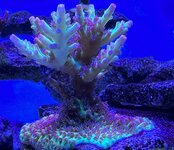

Nice picture.In my current dry rock tank I had to dose 0.16 ppm of PO4 daily for about one full year before it finally saturated. That’s not a typo, 0.16 ppm daily for about a year. I can only imagine where the tank would have went had I not kept the N/P ratio where it needed to be. Now that the first year is behind, I’m seeing the tank come to life. At 3 years it should be nice and juicy, but still a Ghetto compared to the food available in the ocean. I did add 10 lbs of LR about 4 months in, because I could see it was basically going nowhere. The Dry rock was outcompeting the corals and the Biome. I slowly shifted the balance little by little, and kept dosing a high quality (very bioavailable) PO4 which basically saved the tank from certain death!Well maybe not death, but the headaches would have lasted much longer had I not added 10 lbs of LR and dosed PO4 and Nitrogen. Will probably never start another tank w/o some LR in the system. It just brings in some much needed diversity. Only downfall is it brings in a lot of pests with it as I’m sure you’re familiar with Gulf Live Rock. Anyway, this year should be much better. Looking forward to some of these corals growing into colonies.

“Testing needs to be done for N&P and Trace Elements periodically if you want a thriving reef.”
After 52 years of Reefing, I am more than satisfied with my results. When you show me sponges, flame scallops and sea apples in captivity, I might consider “your way”.
“Let’s just be honest, a good skimmer is the single best thing for aeration/gas exchange.”
@Reefahholic
Not sure who you are talking to here. Did you provide some scientific peer reviewed data to document the results you allude too.
For certain, protein skimmers remove the microbial loop that I use to feed flame scallops and NPS Gorgonions.
Did you read Ken Felderman research on protein skimmers in reef aquarium?

 reefs.com
reefs.com
Departments of Chemistry (Ken S. Feldman, Allison A. Place) and Industrial and Manufacturing Engineering (Sanjay Joshi), The Pennsylvania State University, University Park, Pennsylvania 16802, and Route 66 Marine, Gardena, California (Gary White)
Aquaria subjected to active filtration via skimming present water column bacteria populations that are approximately 1/10 of those observed on natural reefs. The consequences of this disparity on the long-term health of the tank’s livestock are not known. How do reef tank organisms adapt to such a bacteria-deficient environment? Is the whole food web in an aquarium perturbed, or are there compensatory mechanisms that maintain an appropriate energy transduction through all of the trophic levels? Is “old tank syndrome” related to possible nutritional deficiencies stemming from this bacteria “gap”? Alternatively, could “old tank syndrome” be symptomatic of a gradual decrease of bacterial diversity as a consequence of selective skimmer-based removal of only bubble-susceptible bacteria? At present, it is not possible to go beyond speculation on these points – further research is needed.
@Reefahholic
Not sure who you are talking to here. Did you provide some scientific peer reviewed data to document the results you allude too.
For certain, protein skimmers remove the microbial loop that I use to feed flame scallops and NPS Gorgonions.
Did you read Ken Felderman research on protein skimmers in reef aquarium?

Bacterial Counts in Reef Aquarium Water: Baseline Values and Modulation by Carbon Dosing, Protein Skimming, and Granular Activated Carbon Filtration
What are the bacteria populations in the water column of reef tanks, and how does that value compare with bacterial counts in authentic reef water? Does carbon dosing indeed increase water column bacteria populations (i.e., is growth carbon limited)? Does mechanical filtration (protein skimming...
Bacterial Counts in Reef Aquarium Water: Baseline Values and Modulation by Carbon Dosing, Protein Skimming, and Granular Activated Carbon Filtration
by Ken S. Feldman | Mar 3, 2011 | 0 commentsDepartments of Chemistry (Ken S. Feldman, Allison A. Place) and Industrial and Manufacturing Engineering (Sanjay Joshi), The Pennsylvania State University, University Park, Pennsylvania 16802, and Route 66 Marine, Gardena, California (Gary White)
4. Conclusions
The preliminary studies described herein document, for the first time, the modulation of water column bacteria population in reef tank water as a consequence of either (a) carbon source addition or (b) mechanical filtration (GAC, skimming). This information bears on the Carbon Dosing hypothesis for nutrient removal in marine aquaria.Aquaria subjected to active filtration via skimming present water column bacteria populations that are approximately 1/10 of those observed on natural reefs. The consequences of this disparity on the long-term health of the tank’s livestock are not known. How do reef tank organisms adapt to such a bacteria-deficient environment? Is the whole food web in an aquarium perturbed, or are there compensatory mechanisms that maintain an appropriate energy transduction through all of the trophic levels? Is “old tank syndrome” related to possible nutritional deficiencies stemming from this bacteria “gap”? Alternatively, could “old tank syndrome” be symptomatic of a gradual decrease of bacterial diversity as a consequence of selective skimmer-based removal of only bubble-susceptible bacteria? At present, it is not possible to go beyond speculation on these points – further research is needed.
“Many of these elements are extremely important for metabolic processes, light protection, microfauna populations, and the entire biome as a whole. I know you understand that, and I’m surprised you’re being so passive with your reef. There is a difference between a thriving reef and a surviving reef you know!  ”
”
While you may use ICP to test inorganic nutrients, you have no idea of the diversity of bacteria in your systems. Bacteria run the microbial loop.
@Reefahholic,
I will take you to task on your erroneous assumptions of my passive methods: Do you culture & feed live phytopkankton? I regularly get live bivalves to feed system live bacteria. I regularly dose liquid seaweed concentrate.
I already posted this information on this thread on how I carbon dose With both organic & inorganic carbon
While you may use ICP to test inorganic nutrients, you have no idea of the diversity of bacteria in your systems. Bacteria run the microbial loop.
@Reefahholic,
I will take you to task on your erroneous assumptions of my passive methods: Do you culture & feed live phytopkankton? I regularly get live bivalves to feed system live bacteria. I regularly dose liquid seaweed concentrate.
I already posted this information on this thread on how I carbon dose With both organic & inorganic carbon
Attachments
There must be a million ways to be an unsuccessful reefer and lots of ways to achieve your goals as a successful reefer. Seems to me that “success” is an individual benchmark though. To some, using the latest gear, testing and methods this means chasing elements and focusing on making sure SPS in particular has more than enough ambient elemental support to grow and develop at maximum speed. To others, testing, fancy gear and modern methods don’t mean much as long as base principles of nature are followed. very different approach, very different results. Both Successful in their own, very different, ways.
soymilk
Supporting Member
when an unstoppable force meets an unmovable object


Thank you for that wisdom & discernment.There must be a million ways to be an unsuccessful reefer and lots of ways to achieve your goals as a successful reefer. Seems to me that “success” is an individual benchmark though. To some, using the latest gear, testing and methods this means chasing elements and focusing on making sure SPS in particular has more than enough ambient elemental support to grow and develop at maximum speed. To others, testing, fancy gear and modern methods don’t mean much as long as base principles of nature are followed. very different approach, very different results. Both Successful in their own, very different, ways.
A quote from Eric Borneman, “Run from anyone that tells you their way is the only way to run a reef tank”.












